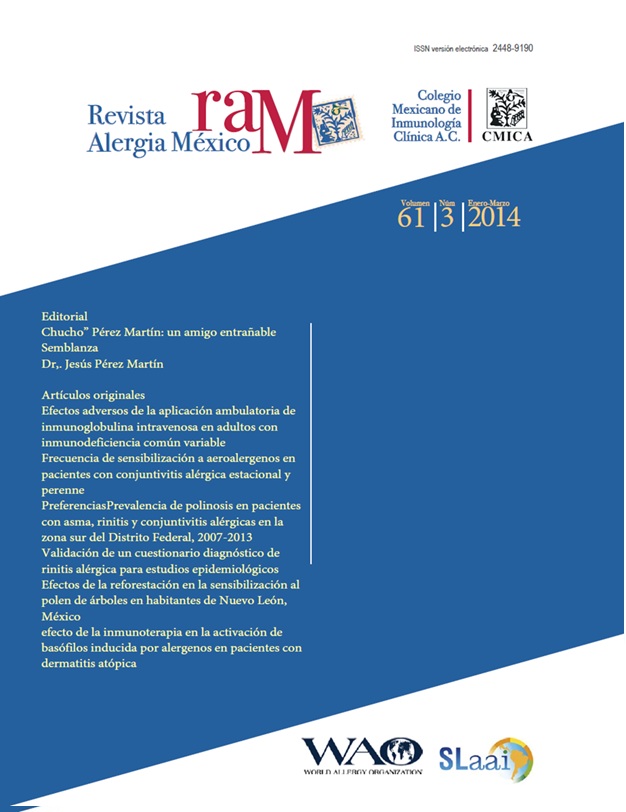Abstract
Background: Allergic rhinitis is the most frequent allergic disease, characterized by nasal symptoms consisting of rhinorrhea, nasal block-age and sneezing triggered by and IgE mediated reaction to allergens.
Objective: To validate a questionnaire for the clinical diagnosis of allergic rhinitis.
Material and method: A test of a test in which a questionnaire for the clinical diagnosis of allergic rhinitis was developed and validated it in 300 subjects (150 children, 150 adults, of both genders, 2-70 years), in allergy specialized centers, between November 2012 and February 2014. Half of the subjects had allergist-diagnosed allergic rhinitis, the other half served as a control group. In patients below 12 years of age the questionnaire was applied to the parents. All questionnaires were applied in duplicate within a time-span of several weeks to validate the intra-subject consistency.
Results: The tests applied to the answers of the questionnaire demonstrated an acceptable concordance in the Test-Retest for both, adults and children. Likewise, we found a very high inter-rater reliability: the agreement between 2 physicians being almost perfect. The test used for validation of the criteria in the adult questionnaire obtained 91% sensitivity, 89% speci city, PPV 89% and NPV 92% and in the children’s questionnaire 92% sensitivity and 93% speci city, PPV 93% and NPV 92% and the criteria for content validity and expression were properly met. The homogeneity test reached 0.7 (Alpha Cronbach).
Conclusion: The questionnaire for allergic rhinitis in children and adults reached a highly acceptable inter-rater reliability, with high sensitivity and speci city in the validation of the criteria and an acceptable grade in the homogeneity test.
México
References
Howarth PH. ABC of allergy: pathogenic mechanisms rational basis for treatment. BMJ 1998;316:758.
Dykewicz MS, Fineman, S, Skoner DP, Nicklas R, et al. Diagnosis and management of rhinitis: complete guidelines of the Joint Task Force on Practice Parameters in Allergy, Asthma and Immunology. American Academy of Allergy, Asthma, and Immunology. Ann Allergy Asthma Immunol 1998;81:478-518.
Strachan D, Sibbald B, Weildan S, et al. Worldwide varitions in prevalence of symptoms of allergic rhinoconjunctivits in children. International Study of Asthma and Allergies in Childhood (ISAAC). Pediatr Allergy Immunol 1997;8:161.
Meltzer EO. The relationships of rhinitis and asthma. Allergy Asthma Proc 2005;26.336-340.
Togias A. Rhinitis and asthma: evidence for respiratory system integration. J Allergy Clin Immunol 2007;111.
Nogueira SL. Control of allergic rhinitis and asthma testformal approach to the development of a measuring tool. Respir Res 2009;10:52.
Kim H. Validating childhood sympton with physician diagnosed allergic rinitis. Ann Allergy Asthma Immunol 2012;108:228-231.
Quillen DM, Feller DB. Diagnosis rinitis allergic vs no allergic. Am Fam Phys 2006;73:1583-1590.
Blaiss MS. Allergic rhinoconjunctivitis: burden of disease. Allergy Asthma Proc 2007;28:393-397.
Meltzer EO, Blaiss MS, Derebery MJ, Mahr TA, et al. Burden of allergic rhinitis: results from the pediatric allergies in America survey. J Allergy Clin Immunol 2009;124:S43-S70.
Deb A, Mukherjee S, Saha BK, et al. Profile of patients with allergic rhinitis: A clinic based cross-sectional study, from Kolkata, India. J Clin Diagn Res 2014;8:67-70.
Sonomjamts M, Dashdemberel S, Logii N, Nakae K, et al. Prevalence of asthma and allergic rhinitis among adult population in Ulaanbaatar, Mongolia. Asia Pac Allergy 2014;4:25-31.
Tatto-Cano MI, Sanín-Aguirre LH, González V, Ruiz-Velasco S, et al. Prevalencia de asma, rinitis y eczema en escolares de la ciudad de Cuernavaca, Morelos. Salud Pública México 1997;39:497-506.
Del Río NB, Luna PJ, Berber A, et al. Factors associated with allergic rhinitis in children from norther Mexico city. J Investig Clin Immunol 2007;17:77-84.

This work is licensed under a Creative Commons Attribution-NonCommercial 4.0 International License.
Copyright (c) 2014 Revista Alergia México

